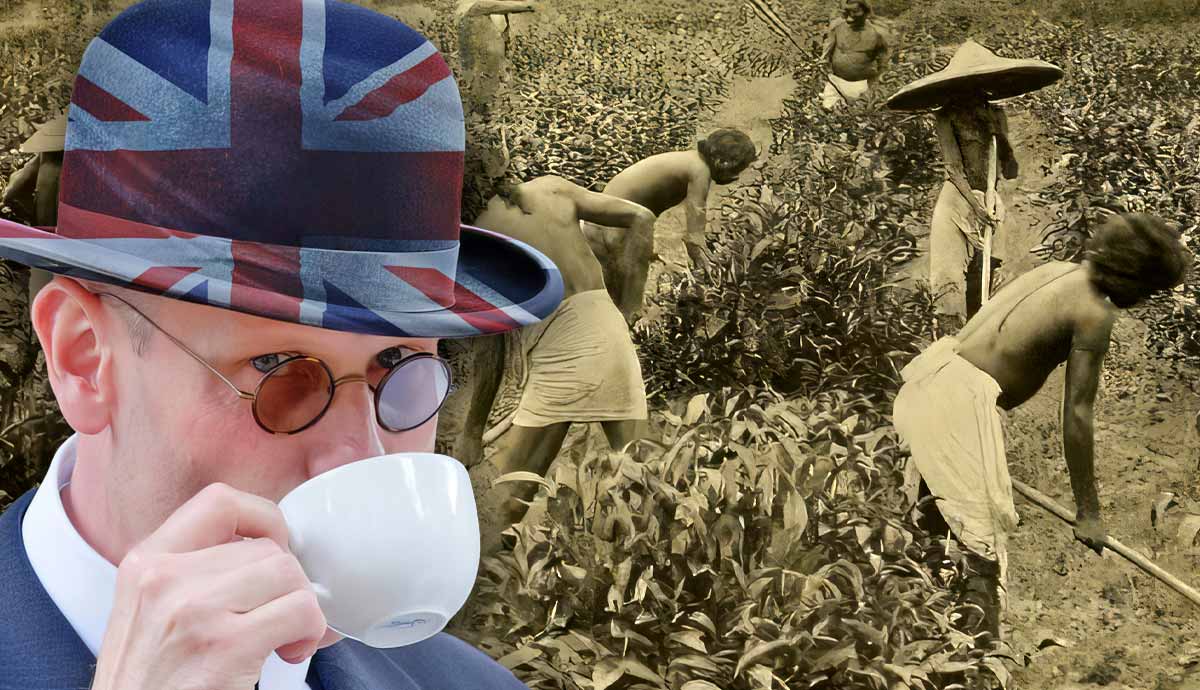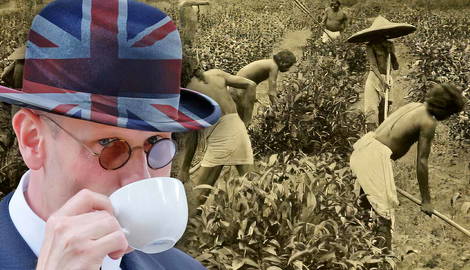
While tea has been consumed for thousands of years in China, it was Britain’s thirst for wealth and power that led to the development of a global tea industry. The East India Company played a pivotal role in this story, from the beginnings of the trade in tea from Canton to Britain, to the transplantation of the tea industry from China to British India, and the eventual emergence of tea as a mass consumer beverage.
The East India Company in Canton

Originally chartered in 1600 by Elizabeth I, the East India Company (EIC) came into its own after being granted a more comprehensive charter in 1657. As a newly minted joint-stock company, one major aspect of its business was tea. From 1713, the EIC established a trading factory in the Chinese trading port of Canton, and got to work.
Initially, tea was a luxury item exclusive to the British upper classes. However, following a surge in trade and massively increased shipments to Europe, prices gradually fell. By the close of the eighteenth century, tea had become a regular item of mass consumption in Britain.
As the demand for tea in Europe grew stronger, the combined efforts of the East India Company, alongside smugglers, private merchants, and shopkeepers, played a pivotal role in shaping a nation of tea-drinkers on the British isles.
Tea for the Masses

Before long, tea was available to the middle classes and over the course of the eighteenth century, became a common sight on the shelves of British grocers. In 1717, Thomas Twining, a former East India Company employee, opened London’s inaugural dry tea emporium, in the process laying the foundations for the cherished British tradition of afternoon tea.
Advertisers pushed fine and exotic tea as a sophisticated way for polite society to pass the time. Yet, by and large, high quality tea was still not readily available to the mass of society at prices they could afford.
This led to a roaring underground tea trade. Used tea leaves were in ready supply. Sloes, elderflower buds and roasted leaves also were passed off and sold as ‘tea.’ Most importantly, cheap black tea procured from Canton by the Swedish East India Company was blended, packed and smuggled into Britain to cater for the masses.
The Great British Tea Heist

Despite their enthusiasm for selling and drinking tea, Europeans possessed only a limited knowledge about tea cultivation in the early 1800s. At the time, it was commonly assumed that northern China was the exclusive hub of tea cultivation.
However, perception quickly changed when in the 1820s, a British soldier stumbled upon wild tea growing in Assam, just outside the empire’s borders. The British authorities swiftly (and violently) annexed the tea-laden territories, and paved the way for the establishment of a “British” tea industry within the empire. The British tea industry in Assam was finally established through a remarkable act of corporate espionage. Commissioned by the EIC, Robert Fortune, a young Scottish Botanist, travelled to northern China, with a brief to steal the secrets of Chinese tea cultivation. Disguised as a Chinese merchant named Sing Wa, Fortune gathered priceless insights and transported thousands of black tea seeds to India. His actions altered the tea industry forever.
Identity in a Teacup

By the 1890s, the British were primarily drinking tea cultivated within the empire at an affordable price. Marketeers used mass advertising and distinct packaging to claim that “British” tea was modern, healthy, pure, and patriotic. Most importantly, tea was said to be unequivocally “British” (Rappaport, 2017, p. 8).
In the wake of the Opium Wars anti-Chinese sentiment was high. In this context, British tea was marketed as “pure” as opposed to that of the Chinese, said to be “contaminated” and laced with the “sweat and dirt” of Chinese laborers.
Thus, emerging attitudes, behaviors and rituals around the consumption of tea were set in the context of empire. In the form of the tea trade, imperialism and consumerism intertwined, to produce a new consuming public. British identity was increasingly located in the consumption of tea.
A Nice Cup of Tea

By the twentieth century tea had become an integral part of British identity. Notably, during the first and second world wars, tea was initially exempt from rationing, such was its importance to morale. Tea-drinking during wartime also served to keep British troops alert, hydrated and away from alcohol. In contrast, John Lennon and Yoko Ono drank tea in bed for peace.
From the mad hatter in Lewis Carroll’s Alice’s Adventures in Wonderland, to iconic figures like Mary Poppins, and Star Trek’s Jean-Luc Picard, many of Britain’s most cherished characters are passionate tea drinkers. George Orwell once declared that “tea is one of the mainstays of civilization in this country.”
Over the course of three and a half centuries, tea-drinking has become an everyday part of the lives of millions of Britons. At time of writing, it is estimated that a remarkable 165 million cups of tea are drunk in the United Kingdom every day.










